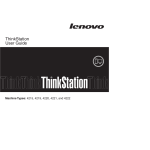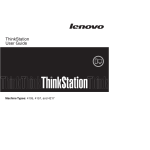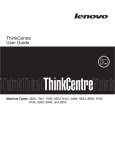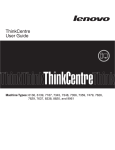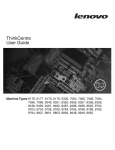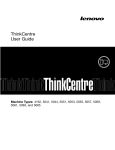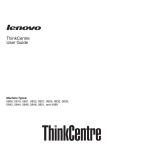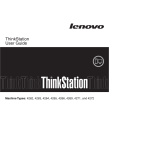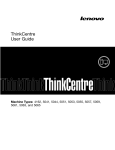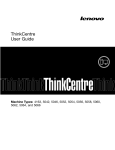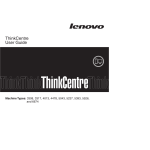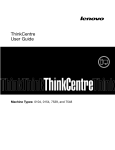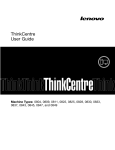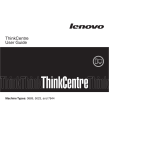Download Lenovo 1165 User's Manual
Transcript
ThinkCentre User Guide Note Before using this information and the product it supports, be sure to read and understand the ThinkCentre Safety and Warranty Guide and “Notices,” on page 39. First Edition (February 2010) © Copyright Lenovo 2010. LENOVO products, data, computer software, and services have been developed exclusively at private expense and are sold to governmental entities as commercial items as defined by 48 C.F.R. 2.101 with limited and restricted rights to use, reproduction and disclosure. LIMITED AND RESTRICTED RIGHTS NOTICE: If products, data, computer software, or services are delivered pursuant a General Services Administration ″GSA″ contract, use, reproduction, or disclosure is subject to restrictions set forth in Contract No. GS-35F-05925. Contents Important safety information . . . . . . v Chapter 1. Product overview . . . . . . 1 Features . . . . . . . . . . . . . . . . 1 Specifications . . . . . . . . . . . . . . 3 Software overview . . . . . . . . . . . . 3 Software provided with your Windows operating system . . . . . . . . . . . . . . . 3 Locating computer connectors and parts . . . . . 6 Adjusting the computer stand . . . . . . . . 8 Selecting a startup device. . . . . . Selecting a temporary startup device . Viewing or changing the startup device Exiting the Setup Utility program . . . . . . . . . . . sequence . . . . Chapter 5. Updating system programs 23 23 24 24 25 Using system programs . . . . . . . . . . 25 Updating (flashing) the BIOS from a disc . . . . 25 Updating (flashing) the BIOS from your operating system . . . . . . . . . . . . . . . . 26 Chapter 2. Installing or replacing hardware . . . . . . . . . . . . . . 9 Chapter 6. Troubleshooting and diagnostic programs . . . . . . . . . 27 Installing or replacing hardware . . Installing external options . . . Installing a computer wall mount Replacing the keyboard or mouse Obtaining device drivers . . . . Basic security features . . . . . Integrated cable lock . . . . Password protection . . . . Basic troubleshooting . . . . . . Diagnostic programs . . . . . . Lenovo ThinkVantage Toolbox . . Lenovo System Toolbox . . . . PC-Doctor for Rescue and Recovery PC-Doctor for DOS . . . . . . Cleaning the mouse . . . . . . Optical mouse . . . . . . . Non-optical mouse . . . . . . . . . . . . . . . . . . . . . . . . . . . . . . Chapter 3. Recovery information Creating and using recovery media . . . Creating recovery media . . . . . . Using recovery media . . . . . . . Performing backup and recovery operations Performing a backup operation . . . . Performing a recovery operation . . . Using the Rescue and Recovery workspace . Creating and using a rescue medium . . . Creating a rescue medium . . . . . Using a rescue medium . . . . . . Installing or reinstalling device drivers . . Solving recovery problems . . . . . . . . . . . . . . . . . . . . . . . 9 . 9 . 9 . 10 . 10 . 10 . 11 . 11 . . . 13 . . . . . . . . . . . . . . . . . . . . . . . . . . . . . . . . . . . . 13 13 14 15 15 16 16 17 18 18 19 19 Chapter 4. Using the Setup Utility program . . . . . . . . . . . . . . 21 Starting the Setup Utility program . . . . Viewing or changing settings . . . . . Using passwords . . . . . . . . . Password considerations . . . . . . User password . . . . . . . . . Administrator password . . . . . . Setting, changing, or deleting a password Enabling or disabling a device . . . . . © Copyright Lenovo 2010 . . . . . . . . . . . . . . . . . . . . . . . . 21 21 21 22 22 22 22 23 . . . . . . . . . . . . . . . . . . . . . . . . . . . . . . . . . . . . . . . . . . . . . 27 28 28 29 29 29 30 30 31 Chapter 7. Getting information, help, and service . . . . . . . . . . . . . 33 Information resources . . . . . . . . . Online Books folder . . . . . . . . Lenovo ThinkVantage Tools . . . . . . ThinkVantage Productivity Center . . . . Lenovo Welcome . . . . . . . . . Access Help . . . . . . . . . . . Safety and warranty . . . . . . . . Lenovo Web site (http://www.lenovo.com). Help and service . . . . . . . . . . Using the documentation and diagnostic programs . . . . . . . . . . . . Calling for service . . . . . . . . . Using other services . . . . . . . . Purchasing additional services . . . . . . . . . . . . . . . . . . . . . . . 33 33 33 34 34 34 34 35 35 . . . . . . . . 35 35 36 37 Appendix. Notices . . . . . . . . . . 39 Television output notice . . . . European conformance CE mark . Trademarks . . . . . . . . . . . . . . . . . . . . . . . . 40 . 40 . 40 Index . . . . . . . . . . . . . . . 41 iii iv User Guide Important safety information CAUTION: Before using this manual, be sure to read and understand all the related safety information for this product. Refer to the ThinkCentre Safety and Warranty Guide that you received with this product for the latest safety information. Reading and understanding this safety information reduces the risk of personal injury and or damage to your product. If you no longer have a copy of the ThinkCentre Safety and Warranty Guide, you can obtain a Portable Document Format (PDF) version from the Lenovo® Support Web site at: http://www.lenovo.com/support © Copyright Lenovo 2010 v vi User Guide Chapter 1. Product overview This chapter provides information about the computer features, specifications, preinstalled software programs, connector and part locations, and how to adjust the computer stand. This chapter contains the following topics: v “Features”: This section provides information about the computer features. v “Specifications” on page 3: This section lists the physical specifications for your computer. v “Software overview” on page 3: This section provides information about the software programs provided with your computer. v “Locating computer connectors and parts” on page 6: This section provides information to help you locate your computer connectors and parts. v “Adjusting the computer stand” on page 8: This section provides instructions on how to adjust your computer stand. Features This section provides information about the computer features. System information The following information covers a variety of models. For information about your specific model, use the Setup Utility program. See Chapter 4, “Using the Setup Utility program,” on page 21. Microprocessor Your computer comes with one of the following microprocessors (internal cache size varies by model type): v Intel® Celeron® dual-core microprocessor v Intel Core™2 Duo microprocessor v Intel Pentium® dual-core microprocessor Memory module(s) v For machine types 1165, 1184, and 1186, support up to two double data rate 2 dual inline memory modules (DDR2 DIMMs) v For machine types 0401, 0994, and 2565, support up to two double data rate 3 dual inline memory modules (DDR3 DIMMs) Internal drives v One optical drive v One Serial Advanced Technology Attachment (SATA) hard disk drive Audio subsystem v Integrated high-definition (HD) audio v Microphone connector and headphone connector v Internal speaker © Copyright Lenovo 2010 1 Connectivity v 10/100/1000 Mbps Ethernet controller System management features v Ability to store the power-on self-test (POST) hardware test results v Advanced Configuration and Power Interface (ACPI) support v Automatic power-on startup v Desktop Management Interface (DMI) v Preboot Execution Environment (PXE) v System Management (SM) Basic Input/Output System (BIOS) and SM software v Wake on LAN Input/Output (I/O) features v Ethernet connector v One 9-pin serial port v Six Universal Serial Bus (USB) connectors v Two audio connectors (headphone connector and microphone connector) Expansion v One hard disk drive bay v One optical drive bay Power supply v 130-watt power supply Security features v Computrace v Enabling or disabling SATA devices v v v v Enabling or disabling USB connectors Startup sequence control Startup without keyboard or mouse Support for the addition of an integrated cable lock (Kensington lock) v User password and administrator password for BIOS access Preinstalled software programs Your computer is preinstalled with some software programs to help you work more easily and securely. For more information, see “Software overview” on page 3. Preinstalled operating system Your computer is preinstalled with one of the following operating systems: v Microsoft® Windows® 7 v Microsoft Windows XP Professional (preinstalled through downgrade rights in Windows 7 Professional) 2 User Guide Operating system(s), certified or tested for compatibility1 (varies by model type) v Linux® Specifications This section lists the physical specifications for your computer. Dimensions Width: 472 mm (18.58 inches) Height: 355 mm (13.98 inches) Depth: 70 mm (2.76 inches) Weight Maximum configuration as shipped: 7.2 kg (15.87 lbs) Environment Air temperature: Operating: 10° to 35°C (50° to 95°F) Non-operating: -20° to 50°C (-4° to 122°F) (with package) Humidity: Operating: 20% to 80% (10% per hour, non condensing) Non-operating: 10% to 90% (10% per hour, non condensing) Altitude: Operating: -50 to 10 000 ft (-15.2 to 3 048 m) Non-operating: -50 to 35 000 ft (-15.2 to 10 668 m) Electrical input Input voltage: Low range: Minimum: 100 V ac Maximum: 127 V ac Input frequency range: 50 to 60 Hz High range: Minimum: 200 V ac Maximum: 240 V ac Input frequency range: 50 to 60 Hz Software overview The computer comes with a preinstalled operating system and several preinstalled applications. Software provided with your Windows operating system This section provides information about the software provided with your Windows operating system. 1. The operating system(s) listed here are being certified or tested for compatibility at the time this publication goes to press. Additional operating systems might be identified by Lenovo as compatible with your computer following the publication of this manual. This list is subject to change. To determine if an operating system has been certified or tested for compatibility, check the Web site of the operating system vendor. Chapter 1. Product overview 3 Software provided by Lenovo The following software programs are provided by Lenovo to help you improve productivity and reduce the cost associated with maintaining your computer. Software programs provided with your computer might vary depending on your model type and preinstalled operating system. Lenovo ThinkVantage Tools: The Lenovo ThinkVantage® Tools program guides you to a host of information sources and provides easy access to various tools to help you work more easily and securely. For more information, see “Lenovo ThinkVantage Tools” on page 33. Note: The Lenovo ThinkVantage Tools program is only available on computers with the Windows 7 operating system from Lenovo. ThinkVantage Productivity Center: The ThinkVantage Productivity Center program guides you to a host of information sources and tools to help you set up, understand, and maintain your computer, and enhance your computer performance. For more information, see “ThinkVantage Productivity Center” on page 34. Note: The ThinkVantage Productivity Center program is only available on computers preinstalled with the Windows XP operating system from Lenovo. Lenovo Welcome: The Lenovo Welcome program introduces some innovative built-in features of Lenovo to you and guides you through some important setup tasks to help you make the most of your computer. Note: The Lenovo Welcome program is only available on computers preinstalled with the Windows 7 operating system from Lenovo. Product Recovery: The Product Recovery program enables you to restore the contents of the hard disk drive to the factory default settings. ThinkVantage Rescue and Recovery: The ThinkVantage Rescue and Recovery® (RnR) program is a one button recovery and restore solution that includes a set of self-recovery tools to help you diagnose computer problems, get help, and recover from system crashes, even if you cannot start the Windows operating system. Note: The ThinkVantage Rescue and Recovery program is only available on machine types 0401, 0994, and 2565. Power Manager: The Power Manager program provides convenient, flexible, and complete power management for your ThinkCentre® computer. By using the Power Manager program, you can adjust your power settings to achieve the best balance between system performance and power saving. ThinkVantage System Update: The ThinkVantage System Update (TVSU) program helps you keep the software on your computer up-to-date by downloading and installing software packages (ThinkVantage applications, device drivers, BIOS updates, and other third party applications). Some examples of software that you should keep updated are programs provided by Lenovo, such as the Rescue and Recovery program and the ThinkVantage Productivity Center program. 4 User Guide Lenovo ThinkVantage Toolbox The Lenovo ThinkVantage Toolbox program helps you maintain your computer, improve computing security, diagnose computer problems, get familiar with the innovative technologies provided by Lenovo, and get more information about your computer. For more information, see “Lenovo ThinkVantage Toolbox” on page 28. Note: The Lenovo ThinkVantage Toolbox program is only available on computers preinstalled with the Windows 7 operating system from Lenovo. Lenovo System Toolbox The Lenovo System Toolbox program is preinstalled on your computer. This diagnostic program works through the Windows operating system to help you test hardware components of your computer. It can also report operating-systemcontrolled settings that interfere with the correct operation of your system. For more information, see “Lenovo System Toolbox” on page 29. Note: The Lenovo System Toolbox program is only available on computers preinstalled with the Windows XP operating system from Lenovo. PC-Doctor for Rescue and Recovery The PC-Doctor for Rescue and Recovery diagnostic program is preinstalled on your ThinkCentre computer as part of the Rescue and Recovery workspace to help you diagnose hardware problems. It can also report operating-system-controlled settings that interfere with the correct operation of your system. Use the PC-Doctor for Rescue and Recovery diagnostic program if you are unable to start the Windows operating system. For more information, see “PC-Doctor for Rescue and Recovery” on page 29. Note: The PC-Doctor for Rescue and Recovery diagnostic program is only available on machine types 0401, 0994, and 2565. Adobe Reader The Adobe Reader program is a tool used to view, print, and search PDF documents. See “Online Books folder” on page 33 for more information about accessing and viewing the publications. Antivirus software Your computer comes with antivirus software that you can use to detect and eliminate viruses. Lenovo provides a full version of antivirus software on your computer with a free 30-day subscription. After 30 days, you must renew the license to continue receiving the antivirus software updates. For more information about how to use your antivirus software, refer to the help system of your antivirus software. Chapter 1. Product overview 5 Locating computer connectors and parts This section provides information to help you locate your computer connectors and parts. Figure 1. Front view 1 Integrated camera (available in some models) 2 Integrated microphone 3 Brightness controls 4 USB connectors (3) 5 Headphone connector 6 User Guide 6 Microphone connector 7 Power switch 8 Power indicator light-emitting diode (LED) 9 Internal speakers (2) Figure 2. Rear view 1 Power cord connector 2 Ethernet connector 3 USB connectors (3) 4 Serial port 5 Integrated cable lock slot 6 Optical drive Chapter 1. Product overview 7 Adjusting the computer stand Your computer comes with a computer stand that you can use to adjust the computer to your comfortable position. Pull the stand open and adjust the position of the computer at an angle between 10° to 35° as shown in the following illustration. CAUTION: Make sure that the angle is at least 10° from the vertical; otherwise, the computer might be unstable and fall over. 35° 10° Figure 3. Adjusting the computer stand 8 User Guide Chapter 2. Installing or replacing hardware This chapter provides instructions on how to install or replace hardware for your computer. This chapter contains the following topics: v “Installing or replacing hardware” v “Obtaining device drivers” on page 10 v “Basic security features” on page 10 Installing or replacing hardware This section provides instructions on how to install or replace hardware for your computer. You can maintain your computer or expand the capabilities of your computer by installing or replacing hardware. Notes: 1. Use only computer parts provided by Lenovo. 2. When installing or replacing an option, use the appropriate instructions in this section along with the instructions that come with the option. Installing external options You can install external options to your computer, such as external speakers, a printer, or a scanner. For some external options, you must install additional software in addition to making the physical connection. When you install an external option, see “Locating computer connectors and parts” on page 6 to identify the required connector. Then, use the instructions that come with the option to help you make the connection and install any software or device drivers that are required for the option. Installing a computer wall mount Your computer supports UL (Underwriters Laboratories) certified 100 mm × 100 mm (3.94 inches × 3.94 inches) wall mounts. For proper mounting, use four screws of the following specifications: Diameter × Pitch × Length: 4 mm × 0.7 mm × 10 mm (0.16 inch × 0.03 inch × 0.39 inch) Note: When installing a computer wall mount, make sure that you leave at least a 60 mm (2.36 inches) space between the wall and your computer for easy access to the connectors on the rear of your computer. © Copyright Lenovo 2010 9 Replacing the keyboard or mouse Attention Do not attempt any repair before reading and understanding the “Important safety information” in the ThinkCentre Safety and Warranty Guide that came with your computer. To obtain a copy of the ThinkCentre Safety and Warranty Guide, go to: http://www.lenovo.com/support This section provides instructions on how to replace the keyboard or mouse. To replace the wireless keyboard or mouse, refer to the instructions that come with the wireless keyboard or mouse. You can also refer to your Windows Help and Support information system for wireless related instructions. To replace the USB keyboard or mouse, do the following: 1. Remove any media from the drives. Then, turn off all attached devices and the computer. 2. Disconnect all power cords from electrical outlets. 3. Disconnect the old keyboard cable or mouse cable from the computer. 4. Connect a new keyboard or mouse to one of the USB connectors on the computer. See “Locating computer connectors and parts” on page 6. Figure 4. Connecting the USB keyboard or mouse 5. Reconnect all power cords to electrical outlets. Note: In most areas of the world, Lenovo requires the return of the defective Customer Replaceable Units (CRUs). Information about this will come with the new CRUs or will come a few days after you receive the new CRUs. Obtaining device drivers You can obtain device drivers for operating systems that are not preinstalled at http://www.lenovo.com/support. Installation instructions are provided in readme files with the device driver files. Basic security features There are several security options available to help you prevent hardware theft and unauthorized access to your computer. In addition to physical locks, you can also prevent unauthorized use of your computer by a software lock that locks the keyboard until a correct password is typed in. 10 User Guide Integrated cable lock Note: Make sure that any security cables you installed do not interfere with other computer cables. An integrated cable lock, sometimes referred to as the Kensington lock, can be used to secure your computer to a desk, a table, or other non-permanent fixture. The integrated cable lock attaches to the integrated cable lock slot in the rear of your computer and is operated with a key. See “Locating computer connectors and parts” on page 6 for the location of the integrated cable lock slot. This is the same type of lock used with many notebook computers. You can order an integrated cable lock from Lenovo by searching for Kensington at: http://www.lenovo.com/support Password protection To deter unauthorized use of your computer, you can use the Setup Utility program to set a password. When you turn on your computer, you are prompted to type the password. The computer cannot be used until a valid password is typed in. Refer to Chapter 4, “Using the Setup Utility program,” on page 21 for more information. Chapter 2. Installing or replacing hardware 11 12 User Guide Chapter 3. Recovery information This chapter provides information about the recovery solutions provided by Lenovo. This chapter contains the following topics: v “Creating and using recovery media” v “Performing backup and recovery operations” on page 15 v v v v “Using the Rescue and Recovery workspace” on page 16 “Creating and using a rescue medium” on page 17 “Installing or reinstalling device drivers” on page 19 “Solving recovery problems” on page 19 Notes: 1. There are a variety of methods to choose from when considering how to recover in the event of a software- or hardware-related problem. Some methods vary depending on the type of your operating system. 2. The product on the recovery media may be used only for the following purposes: v Restore the product preinstalled on your computer v Reinstall the product v Modify the product using the Additional Files Creating and using recovery media You can use recovery media to restore the hard disk drive to the factory default settings. Recovery media are useful if you transfer the computer to another area, sell the computer, recycle the computer, or put the computer in an operational state after all other methods of recovery have failed. As a precautionary measure, it is important to create recovery media as early as possible. Note: The recovery operations you can perform using recovery media vary depending on the operating system from which the recovery media were created. The recovery media might contain a boot medium and a data medium. Your Microsoft Windows license permits you to create only one data medium, so it is important that you store the recovery media in a safe place after you have made them. Creating recovery media This section provides instructions on how to create recovery media on different operating systems. Note: On the Windows 7 operating system, you can create recovery media using discs or external USB storage devices. On the Windows XP operating system, you can create recovery media using only discs, so this operation is also called ″creating Product Recovery discs.″ v To create recovery media on the Windows 7 operating system, click Start → All Programs → Lenovo ThinkVantage Tools → Factory Recovery Disks. Then, follow the instructions on the screen. © Copyright Lenovo 2010 13 v To create Product Recovery discs on the Windows XP operating system, click Start → All Programs → ThinkVantage → Create Recovery Media. Then, follow the instructions on the screen. Using recovery media This section provides instructions on how to use recovery media on different operating systems. v On the Windows 7 operating system, you can use recovery media to restore the computer to the factory default settings only. You can use recovery media to put the computer in an operational state after all other methods of recovery have failed. Attention: When you use recovery media to restore the computer to the factory default settings, all the files currently on the hard disk drive will be deleted and replaced by the factory default settings. To use recovery media on the Windows 7 operating system, do the following: 1. Depending on the type of your recovery media, connect the boot medium (memory key or other USB storage device) to the computer, or insert the boot disc into the optical drive. 2. Repeatedly press and release the F12 key when turning on the computer. When the Startup Device Menu opens, release the F12 key. 3. Select the desired startup device and press Enter. The restore process begins. 4. Follow the instructions on the screen to complete the operation. Notes: 1. After restoring your computer to the factory default settings, you might have to reinstall device drivers for some devices. See “Installing or reinstalling device drivers” on page 19. 2. Some computers come with Microsoft Office or Microsoft Works preinstalled. If you need to recover or reinstall your Microsoft Office or Microsoft Works applications, you must use the Microsoft Office CD or Microsoft Works CD. These discs are provided only with computers preinstalled with Microsoft Office or Microsoft Works. v On the Windows XP operating system, you can use Product Recovery discs to restore your computer to the factory default settings, perform a custom factory recovery, or perform other rescue and recovery operations such as rescuing individual files. You will be given the option to enter the Rescue and Recovery workspace and choose from a variety of recovery operations. Attention: When you use Product Recovery discs to restore the computer to the factory default settings, all the files currently on the hard disk drive will be deleted and replaced by the factory default settings. During the restore process, you will be given the option to save one or more files currently on the hard disk drive to other media before the data is deleted. To use Product Recovery discs on the Windows XP operating system, do the following: 1. Repeatedly press and release the F12 key when turning on the computer. When the Startup Device Menu opens, release the F12 key. 2. Insert the boot disc into the optical drive. 3. Select the optical drive with the boot disc as the startup device and press Enter. After a short delay, the Rescue and Recovery workspace opens. 4. On the Rescue and Recovery menu, click Restore your system. 5. Follow the instructions on the screen. Insert the appropriate Product Recovery disc when prompted. 14 User Guide Performing backup and recovery operations Note: The information in this section applies only to machine types 0401, 0994, and 2565, which have the Rescue and Recovery program preinstalled. The Rescue and Recovery program enables you to back up all your hard disk drive contents including the operating system, data files, software programs, and personal settings. You can designate where the Rescue and Recovery program stores the backup: v In a protected area of your hard disk drive v On the secondary hard disk drive if a secondary hard disk drive is installed in your computer v On an attached external USB hard disk drive v On a network drive v On recordable discs (a recordable optical drive is required for this option) After you have backed up the contents on the hard disk drive, you can restore the complete contents of the hard disk drive, restore only the selected files, or restore only the Windows operating system and applications. Performing a backup operation This section provides instructions on how to perform a backup operation using the Rescue and Recovery program on different operating systems. v To perform a backup operation using the Rescue and Recovery program on the Windows 7 operating system, do the following: 1. From the Windows desktop, click Start → All Programs → Lenovo ThinkVantage Tools → Enhanced Backup and Restore. The Rescue and Recovery program opens. 2. In the Rescue and Recovery main window, click the Launch advanced Rescue and Recovery arrow. 3. Click Back up your hard drive and select backup operation options. Then, follow the instructions on the screen to complete the backup operation. v To perform a backup operation using the Rescue and Recovery program on the Windows XP operating system, do the following: 1. From the Windows desktop, click Start → All Programs → ThinkVantage → Rescue and Recovery. The Rescue and Recovery program opens. 2. In the Rescue and Recovery main window, click Launch advanced Rescue and Recovery → Back up your hard drive, and select backup operation options. 3. Follow the instructions on the screen to complete the backup operation. Chapter 3. Recovery information 15 Performing a recovery operation This section provides instructions on how to perform a recovery operation using the Rescue and Recovery program on different operating systems. v To perform a recovery operation using the Rescue and Recovery program on the Windows 7 operating system, do the following: 1. From the Windows desktop, click Start → All Programs → Lenovo ThinkVantage Tools → Enhanced Backup and Restore. The Rescue and Recovery program opens. 2. In the Rescue and Recovery main window, click the Launch advanced Rescue and Recovery arrow. 3. Click the Restore your system from a backup icon. 4. Follow the instructions on the screen to complete the recovery operation. v To perform a recovery operation using the Rescue and Recovery program on the Windows XP operating system, do the following: 1. From the Windows desktop, click Start → All Programs → ThinkVantage → Rescue and Recovery. The Rescue and Recovery program opens. 2. In the Rescue and Recovery main window, click Launch advanced Rescue and Recovery. 3. Click the Restore your system from a backup icon. 4. Follow the instructions on the screen to complete the recovery operation. For more information about performing a recovery operation from the Rescue and Recovery workspace, see “Using the Rescue and Recovery workspace.” Using the Rescue and Recovery workspace Note: The information in this section applies only to machine types 0401, 0994, and 2565, which have the Rescue and Recovery program preinstalled. The Rescue and Recovery workspace resides in a protected, hidden area of your hard disk drive that operates independently from the Windows operating system. This enables you to perform recovery operations even if you cannot start the Windows operating system. You can perform the following recovery operations from the Rescue and Recovery workspace: v Rescue files from your hard disk drive or from a backup The Rescue and Recovery workspace enables you to locate files on your hard disk drive and transfer them to a network drive or other recordable media, such as a USB device or a disc. This solution is available even if you did not back up your files or if changes were made to the files since your last backup operation. You can also rescue individual files from a Rescue and Recovery backup located on your local hard disk drive, a USB device, or a network drive. v Restore your hard disk drive from a Rescue and Recovery backup If you have backed up your hard disk drive using the Rescue and Recovery program, you can restore the hard disk drive from a Rescue and Recovery backup, even if you cannot start the Windows operating system. v Restore your hard disk drive to the factory default settings The Rescue and Recovery workspace enables you to restore the complete contents of your hard disk drive to the factory default settings. If you have multiple partitions on your hard disk drive, you have the option to restore the factory default settings to the C: partition and leave the other partitions intact. Because the Rescue and Recovery workspace operates independently from the 16 User Guide Windows operating system, you can restore the factory default settings even if you cannot start the Windows operating system. Attention: If you restore the hard disk drive from a Rescue and Recovery backup or restore the hard disk drive to the factory default settings, all files on the primary hard disk drive partition (usually drive C:) will be deleted in the recovery process. If possible, make copies of important files. If you are unable to start the Windows operating system, you can use the rescue files feature of the Rescue and Recovery workspace to copy files from your hard disk drive to other media. To start the Rescue and Recovery workspace, do the following: 1. Make sure the computer is turned off. 2. Repeatedly press and release the F11 key when turning on the computer. When you hear beeps or see a logo screen, release the F11 key. 3. If you have set a Rescue and Recovery password, type your password when prompted. The Rescue and Recovery workspace opens after a short delay. Note: If the Rescue and Recovery workspace fails to open, see “Solving recovery problems” on page 19. 4. Do one of the following: v To rescue files from your hard disk drive or from a backup, click Rescue files and follow the instructions on the screen. v To restore your hard disk drive from a Rescue and Recovery backup or to restore your hard disk drive to the factory default settings, click Restore your system and follow the instructions on the screen. For more information about the features of the Rescue and Recovery workspace, click Help. Notes: 1. After restoring your hard disk drive to the factory default settings, you might have to reinstall device drivers for some devices. See “Installing or reinstalling device drivers” on page 19. 2. Some computers come with Microsoft Office or Microsoft Works preinstalled. If you need to recover or reinstall your Microsoft Office or Microsoft Works applications, you must use the Microsoft Office CD or Microsoft Works CD. These discs are provided only with computers preinstalled with Microsoft Office or Microsoft Works. Creating and using a rescue medium With a rescue medium, such as a disc or a USB hard disk drive, you can recover the computer from failures that prevent you from gaining access to the Rescue and Recovery workspace on your hard disk drive. Notes: 1. The information in this section applies only to machine types 0401, 0994, and 2565, which have the Rescue and Recovery program preinstalled. 2. The recovery operations you can perform using a rescue medium vary depending on the operating system. 3. The rescue disc can be started in all types of optical drives. 4. You can also run the PC-Doctor for Rescue and Recovery diagnostic program, after using a rescue medium to recover the computer from failures and gaining access to the Rescue and Recovery workspace. Chapter 3. Recovery information 17 Creating a rescue medium This section provides instructions on how to create a rescue medium on different operating systems. v To create a rescue medium on the Windows 7 operating system, do the following: 1. From the Windows desktop, click Start → All Programs → Lenovo ThinkVantage Tools → Enhanced Backup and Restore. The Rescue and Recovery program opens. 2. In the Rescue and Recovery main window, click the Launch advanced Rescue and Recovery arrow. 3. Click the Create Rescue Media icon. The Create Rescue and Recovery Media window opens. 4. In the Rescue Media area, select the type of the rescue medium you want to create. You can create a rescue medium using a disc, a USB hard disk drive, or a secondary internal hard disk drive. 5. Click OK and follow the instructions on the screen to create a rescue medium. v To create a rescue medium on the Windows XP operating system, do the following: 1. From the Windows desktop, click Start → All Programs → ThinkVantage → Create Recovery Media. The Create Rescue and Recovery Media window opens. 2. In the Rescue Media area, select the type of the rescue medium you want to create. You can create a rescue medium using a disc, a USB hard disk drive, or a secondary internal hard disk drive. 3. Click OK and follow the instructions on the screen to create a rescue medium. Using a rescue medium This section provides instructions on how to use the rescue medium you have created. v If you have created a rescue medium using a disc, do the following to use the rescue medium: 1. Turn off your computer. 2. Repeatedly press and release the F12 key when turning on the computer. When the Startup Device Menu opens, release the F12 key. 3. On the Startup Device Menu, select the desired optical drive as the first boot device. Then, insert the rescue disc into the optical drive and press Enter. The rescue medium starts. v If you have created a rescue medium using a USB hard disk drive, do the following to use the rescue medium: 1. Attach the USB hard disk drive to one of the USB connectors on your computer. 2. Repeatedly press and release the F12 key when turning on the computer. When the Startup Device Menu opens, release the F12 key. 3. On the Startup Device Menu, select the USB hard disk drive as the first boot device and press Enter. The rescue medium starts. 18 User Guide v If you have created a rescue medium using the secondary internal hard disk drive, set the secondary internal hard disk drive as the first boot device in the startup device sequence to start the rescue medium. See “Selecting a startup device” on page 23. Note: The secondary internal hard disk drive is only available in some computer models. When the rescue medium starts, the Rescue and Recovery workspace opens. The help information for each feature is available from the Rescue and Recovery workspace. Follow the instructions to complete the recovery process. Installing or reinstalling device drivers Before installing or reinstalling device drivers, make sure that you have a preinstalled operating system and the documentation and software media for the device. Device drivers for factory-installed devices are located on the computer hard disk drive (usually drive C:) in the SWTOOLS\DRIVERS subdirectory. The latest device drivers for factory-installed devices are also available at http://www.lenovo.com/ support. Other device drivers are on the software media that come with individual devices. To install or reinstall the device driver for a factory-installed device, do the following: 1. Turn on the computer. 2. Use Windows Explorer or My Computer to display the directory structure of your hard disk drive. 3. Go to the C:\SWTOOLS directory. 4. Open the DRIVERS folder. Within the DRIVERS folder, there are several subfolders named for various devices installed in your computer, such as AUDIO or VIDEO. 5. Open the appropriate device subfolder. 6. Do one of the following: v In the device subfolder, look for a SETUP.exe file. Double-click the file and follow the instructions on the screen to complete the installation. v In the device subfolder, look for a README.txt file or a file with the .txt extension. This file might be named after the operating system, such as WIN98.txt. The TXT file contains information about how to install the device driver. Follow the instructions to complete the installation. v If the device subfolder contains a file with the .inf extension and you want to install the device driver using the INF file, refer to your Windows Help and Support information system for detailed information about how to install the device driver. Solving recovery problems If you are unable to access the Rescue and Recovery workspace or the Windows environment, do one of the following: Note: The Rescue and Recovery workspace is only available on machine types 0401, 0994, and 2565. Chapter 3. Recovery information 19 v Use a rescue medium to start the Rescue and Recovery workspace. See “Creating and using a rescue medium” on page 17. v Use recovery media if all other methods of recovery have failed and you need to restore the hard disk drive to the factory default settings. See “Creating and using recovery media” on page 13. Note: If you are unable to access the Rescue and Recovery workspace or the Windows environment from a rescue medium or recovery media, you might not have the rescue device (an internal hard disk drive, a disc, a USB hard disk drive, or other external devices) set as the first boot device in the startup device sequence. You must first make sure that your rescue device is set as the first boot device in the startup device sequence in the Setup Utility program. See “Selecting a startup device” on page 23 for detailed information about temporarily or permanently changing the startup device sequence. For more information about the Setup Utility program, see Chapter 4, “Using the Setup Utility program,” on page 21. It is important to create a rescue medium and a set of recovery media as early as possible and store them in a safe place for future use. 20 User Guide Chapter 4. Using the Setup Utility program You can use the Setup Utility program to view and change the configuration settings of your computer, regardless of which operating system you are using. However, the operating system settings might override any similar settings in the Setup Utility program. This chapter provides information about the following topics to help you use the Setup Utility program: v “Starting the Setup Utility program” v v v v v “Viewing or changing settings” “Using passwords” “Enabling or disabling a device” on page 23 “Selecting a startup device” on page 23 “Exiting the Setup Utility program” on page 24 Starting the Setup Utility program This section provides instructions on how to start the Setup Utility program. To start the Setup Utility program, do the following: 1. Make sure your computer is turned off. 2. Repeatedly press and release the F1 key when turning on the computer. When you hear multiple beeps or see a logo screen, release the F1 key. The Setup Utility program opens. Note: If a password has been set, the Setup Utility program menu will not be displayed until you type the correct password. For more information, see “Using passwords.” Viewing or changing settings The Setup Utility program menu lists various items about the system configuration settings. To view or change the settings, start the Setup Utility program. See “Starting the Setup Utility program.” Then, follow the instructions on the screen. When working with the Setup Utility program, you must use the keyboard. The keys used to perform various tasks are displayed at the bottom of each screen. Using passwords By using the Setup Utility program, you can set a password to prevent unauthorized access to your computer and data. The following options are available to help you set a user password or an administrator password: v Set User Password v Set Administrator Password You do not have to set a password to use your computer. However, using a password improves computing security. If you decide to set a password, read the following sections. © Copyright Lenovo 2010 21 Password considerations A password can be any combination of up to 16 (1 to 16) alphabetic and numeric characters. For security reasons, it is recommended to use a strong password that cannot be easily compromised. To set a strong password, use the following guidelines: Note: The Setup Utility program passwords are not case sensitive. v Have at least eight characters in length v Contain at least one alphabetic character and one numeric character v Not be your name or your user name v Not be a common word or a common name v Be significantly different from your previous passwords User password After you have set a user password using the Set User Password option, a password prompt is displayed each time you turn on the computer. You cannot use the computer until a valid password is typed in. For more information on how to set a password, see “Setting, changing, or deleting a password.” Administrator password The Set Administrator Password option enables you to set an administrator password, which deters unauthorized users from changing configuration settings. If you are responsible for maintaining the settings of several computers, you might want to set an administrator password. For more information on how to set a password, see “Setting, changing, or deleting a password.” After you have set an administrator password, a password prompt is displayed each time you try to access the Setup Utility program. You cannot access the Setup Utility program until a valid password is typed in. If you have set both a user password and an administrator password, you can type either password to use your computer. However, to change any configuration settings, you must use your administrator password. Setting, changing, or deleting a password This section provides instructions on how to set, change, or delete a password. To set, change, or delete a password, do the following: 1. Start the Setup Utility program. See “Starting the Setup Utility program” on page 21. 2. From the Setup Utility program main menu, select Security → Set User Password or Set Administrator Password. 3. Follow the instructions on the screen to set, change, or delete a password. Note: A password can be any combination of up to 16 (1 to 16) alphabetic and numeric characters. For more information, see “Password considerations.” 22 User Guide Enabling or disabling a device This section provides instructions on how to enable or disable user access to a device. USB Setup Use this option to set up USB connectors. SATA Controller When this option is set to Disabled, all devices connected to the SATA connectors (such as the hard disk drive or the optical drive) are disabled and will not be displayed in the system configuration. To enable or disable a device, do the following: 1. Start the Setup Utility program. See “Starting the Setup Utility program” on page 21. 2. From the Setup Utility program main menu, select Devices. 3. Depending on the device you want to enable or disable, do one of the following: v Select USB Setup and follow the instructions on the screen to enable or disable the USB connector(s) of your choice. v Select ATA Drives Setup → SATA Controller to enable or disable the devices connected to the SATA connectors on the system board. 4. Select the desired settings and press Enter. 5. Press Esc to return to the Setup Utility program main menu. You might have to press Esc several times. 6. Press F10 to save the new settings and exit the Setup Utility program. Notes: a. If you do not want to save the settings, select Exit → Discard Changes and Exit. b. If you want to return to the default settings, press F9 or select Exit → Load Optimal Defaults. Selecting a startup device If your computer does not start up from a device (such as a hard disk drive or the disc in an optical drive) as expected, do one of the following to select the desired startup device. Selecting a temporary startup device This section provides instructions on how to select a temporary startup device. You can use the instructions in this section to start up from any startup device. Note: Not all discs and hard disk drives are bootable. To select a temporary startup device, do the following: 1. Turn off your computer. 2. Repeatedly press and release the F12 key when turning on the computer. When the Startup Device Menu opens, release the F12 key. 3. Select the desired startup device on the Startup Device Menu and press Enter to begin. Chapter 4. Using the Setup Utility program 23 Note: Selecting a startup device on the Startup Device Menu does not permanently change the startup device sequence. Viewing or changing the startup device sequence This section provides instructions on how to view or permanently change the configured startup device sequence. To view or permanently change the configured startup device sequence, do the following: 1. Start the Setup Utility program. See “Starting the Setup Utility program” on page 21. 2. Select Startup → Primary Boot Sequence. Read the information displayed on the right side of the screen. 3. Select the first boot device, second boot device, and so on. 4. Press Esc to return to the Startup menu. Then, select the devices for the Automatic Boot Sequence and Error Boot Sequence. 5. Press Esc to return to the Setup Utility program main menu. You might have to press Esc several times. 6. Press F10 to save the new settings and exit the Setup Utility program. Notes: a. If you do not want to save the settings, select Exit → Discard Changes and Exit. b. If you want to return to the default settings, press F9 or select Exit → Load Optimal Defaults. Exiting the Setup Utility program After you finish viewing or changing settings, press Esc to return to the Setup Utility program main menu. You might have to press Esc several times. Then, you can do one of the following: v If you want to save the new settings and exit the Setup Utility program, press F10. Otherwise, your changes will not be saved. v If you do not want to save the new settings, select Exit → Discard Changes and Exit. v If you want to return to the default settings, press F9 or select Exit → Load Optimal Defaults. 24 User Guide Chapter 5. Updating system programs This chapter provides information about updating the POST and BIOS, and how to recover from a POST and BIOS update failure. This chapter contains the following topics: v “Using system programs” v “Updating (flashing) the BIOS from a disc” v “Updating (flashing) the BIOS from your operating system” on page 26 Using system programs System programs are the basic layer of software built into your computer. System programs include the POST, the BIOS, and the Setup Utility program. The POST is a set of tests and procedures that are performed each time you turn on your computer. The BIOS is a layer of software that translates instructions from other layers of software into electrical signals that the computer hardware can execute. You can use the Setup Utility program to view or change the configuration and setup of your computer. Your computer system board has a module called electrically erasable programmable read-only memory (EEPROM, also referred to as flash memory). You can easily update the POST, the BIOS, and the Setup Utility program by starting your computer with a system-program-update disc or running a special update program from your operating system. Lenovo might make changes and enhancements to the POST and BIOS. When updates are released, they are available as downloadable files on the Lenovo Web site at http://www.lenovo.com. Instructions for using the POST and BIOS updates are available in a TXT file that is included with the update files. For most models, you can download either an update program to create a system-program-update disc or an update program that can be run from the operating system. Updating (flashing) the BIOS from a disc This section provides instructions on how to update (flash) the BIOS from a disc. Note: You can download a self-starting bootable disc image (known as an ISO image) with the system program updates to create a system-program-update disc. Go to: http://www.lenovo.com/support To update (flash) the BIOS from a disc, do the following: 1. Turn off your computer. 2. Repeatedly press and release the F12 key when turning on the computer. When the Startup Device Menu opens, release the F12 key. 3. On the Startup Device Menu, select the desired optical drive as the first boot device. Then, insert the disc into the optical drive and press Enter. The update begins. © Copyright Lenovo 2010 25 4. When prompted to change the serial number, it is suggested that you press N. However, if you do want to change the serial number, press Y, then type in the serial number and press Enter. 5. When prompted to change the machine type and model, it is suggested that you press N. However, if you do want to change the machine type and model, press Y, then type in the machine type and model and press Enter. 6. Follow the instructions on the screen to complete the update. After the update is completed, remove the disc from the optical drive. Updating (flashing) the BIOS from your operating system Note: Because Lenovo makes constant improvements to its Web sites, the Web page contents are subject to change without notice, including the contents referenced in the following procedure. To update (flash) the BIOS from your operating system, do the following: 1. Go to http://www.lenovo.com/support. 2. Do the following to locate the downloadable files for your machine type: a. In the Enter a product number field, type your machine type and click Go. b. Click Downloads and drivers. c. Select BIOS from the Refine results drop-down list box to easily locate all the BIOS related links. d. Click the BIOS update link. 3. Click the TXT file that contains the instructions for updating (flashing) the BIOS from your operating system. 4. Print these instructions. This is very important because these instructions will not be displayed on the screen after the download begins. 5. Follow the printed instructions to download, extract, and install the update. 26 User Guide Chapter 6. Troubleshooting and diagnostic programs This chapter provides information about some basic troubleshooting and diagnostic programs. If your computer problem is not described in this chapter, see Chapter 7, “Getting information, help, and service,” on page 33 for additional troubleshooting resources. This chapter contains the following topics: v “Basic troubleshooting” v “Diagnostic programs” on page 28 v “Cleaning the mouse” on page 30 Basic troubleshooting The following table provides some basic information to help you troubleshoot your computer problems. Note: If you cannot solve the problem after doing the basic troubleshooting, have the computer serviced. Refer to the ThinkCentre Safety and Warranty Guide that came with your computer for the safety and warranty information and the list of Lenovo Support telephone numbers. Symptom The computer does not start when you press the power switch. Action Verify that: v The power cord is correctly connected to the rear of the computer and to a working electrical outlet. v The power indicator on the front of the computer is on. v The computer voltage matches the voltage available at the electrical outlet for your country or region. The monitor screen is blank. Verify that: v The power cord is correctly connected to the rear of the computer and to a working electrical outlet. v The computer voltage matches the voltage available at the electrical outlet for your country or region. v The brightness and contrast controls are set correctly. The USB keyboard or mouse does not work. Verify that: v The computer is turned on. v The USB keyboard or mouse is correctly connected to one of the USB connectors on the computer. v For the USB keyboard, no keys are stuck. v The USB mouse is clean. Refer to “Cleaning the mouse” on page 30. © Copyright Lenovo 2010 27 Symptom Action The wireless keyboard or mouse does not work. Verify that: v The computer is turned on. v The battery or batteries installed in the wireless keyboard or mouse are in good condition. v The wireless configurations are all set correctly. You might need to refer to the documentation that come with the wireless keyboard or mouse, or refer to your Windows Help and Support information system for wireless related instructions. If your wireless mouse has a dongle, make sure the dongle is correctly connected to one of the USB connectors on the computer. v For the wireless keyboard, no keys are stuck. v The wireless mouse is clean. Refer to “Cleaning the mouse” on page 30. The operating system does not start. Verify that you list the device where the operating system resides in the startup device sequence. Usually, the operating system is on the hard disk drive. For more information, see “Selecting a startup device” on page 23. The computer beeps multiple times before the operating system starts. Verify that no keys are stuck. Diagnostic programs Diagnostic programs are used to test hardware components of your computer. Diagnostic programs can also report operating-system-controlled settings that interfere with the correct operation of your system. The following program(s) are preinstalled on your computer to help you diagnose computer problems: v Lenovo ThinkVantage Toolbox or Lenovo System Toolbox, depending on your operating system (used when you are running the Windows operating system) v PC-Doctor for Rescue and Recovery (used when you cannot start the Windows operating system) Note: The PC-Doctor for Rescue and Recovery diagnostic program is only available on machine types 0401, 0994, and 2565. Notes: 1. You can also download the PC-Doctor for DOS diagnostic program from http://www.lenovo.com/support. See “PC-Doctor for DOS” on page 29 for detailed information. 2. If you are unable to isolate and repair the problem yourself after running the programs, save and print the log files created by the programs. You will need the log files when you speak to a Lenovo technical support representative. Lenovo ThinkVantage Toolbox Note: The Lenovo ThinkVantage Toolbox program is only available on computers preinstalled with the Windows 7 operating system from Lenovo. The Lenovo ThinkVantage Toolbox program helps you maintain your computer, improve computing security, diagnose computer problems, get familiar with the innovative technologies provided by Lenovo, and get more information about your computer. You can use the diagnostics feature of the Lenovo ThinkVantage Toolbox program to test devices, diagnose computer problems, create bootable diagnostic media, update system drivers, and view system information. 28 User Guide To run the Lenovo ThinkVantage Toolbox program, click Start → All Programs → Lenovo ThinkVantage Tools → System Health and Diagnostics. Follow the instructions on the screen. For additional information about running the Lenovo ThinkVantage Toolbox program, refer to the Lenovo ThinkVantage Toolbox help system. Lenovo System Toolbox Note: The Lenovo System Toolbox program is only available on computers preinstalled with the Windows XP operating system from Lenovo. The Lenovo System Toolbox program works through the Windows operating system to enable you to test devices, view symptoms and solutions for computer problems, update system drivers, and view system information. To run the Lenovo System Toolbox program, click Start → All Programs → Lenovo Services → Lenovo System Toolbox. Follow the instructions on the screen. For additional information about running the Lenovo System Toolbox program, refer to the Lenovo System Toolbox help system. PC-Doctor for Rescue and Recovery Note: The PC-Doctor for Rescue and Recovery diagnostic program is only available on machine types 0401, 0994, and 2565. The PC-Doctor for Rescue and Recovery diagnostic program is part of the Rescue and Recovery workspace on your Lenovo computer. Use the PC-Doctor for Rescue and Recovery program if you are unable to start the Windows operating system. To run the PC-Doctor for Rescue and Recovery program from the Rescue and Recovery workspace, do the following: 1. Turn off the computer. 2. Repeatedly press and release the F11 key when turning on the computer. When you hear beeps or see a logo screen, release the F11 key. The Rescue and Recovery workspace opens after a short delay. 3. From the Rescue and Recovery workspace, select Launch advanced Rescue and Recovery → Diagnose hardware. The PC-Doctor for Rescue and Recovery program opens. 4. Select the desired diagnostic test. Then, follow the instructions on the screen. For additional information about running the PC-Doctor for Rescue and Recovery program, refer to the PC-Doctor for Rescue and Recovery help system. Note: If you encounter failures that prevent you from gaining access to the Rescue and Recovery workspace, you can run the PC-Doctor for Rescue and Recovery program after using a rescue medium to recover the computer from failures and gaining access to the Rescue and Recovery workspace. See “Creating and using a rescue medium” on page 17. PC-Doctor for DOS You can also download the latest version of the PC-Doctor for DOS diagnostic program from http://www.lenovo.com/support. The PC-Doctor for DOS Chapter 6. Troubleshooting and diagnostic programs 29 diagnostic program runs independently of the Windows operating system. Use the PC-Doctor for DOS diagnostic program if you are unable to start the Windows operating system. You can run the PC-Doctor for DOS diagnostic program from a diagnostic disc that you created. Creating a diagnostic disc This section provides instructions on how to create a diagnostic disc. To create a diagnostic disc, do the following: 1. Download a self-starting bootable disc image (known as an ISO image) of the diagnostic program from: http://www.lenovo.com/support 2. Use any CD/DVD burning software to create a diagnostic disc with the ISO image. Running the diagnostic program from the diagnostic disc This section provides instructions on how to run the diagnostic program from the diagnostic disc that you created. To run the diagnostic program from the diagnostic disc that you created, do the following: 1. Make sure that your computer is turned off. 2. Repeatedly press and release the F12 key when turning on the computer. When the Startup Device Menu opens, release the F12 key. 3. Insert the diagnostic disc into the optical drive. 4. Select the optical drive with the diagnostic disc as the startup device and press Enter. The diagnostic program opens. 5. Follow the instructions on the screen to run the desired diagnostic test. For additional help, press the F1 key. 6. Remove the diagnostic disc from the optical drive after completing the diagnostic test. Cleaning the mouse This section provides instructions on how to clean an optical or non-optical mouse. Optical mouse An optical mouse uses a LED and an optical sensor to navigate the pointer. If the pointer on the screen does not move smoothly with the optical mouse, you might need to clean the mouse. To 1. 2. 3. clean the optical mouse, do the following: Turn off your computer. Disconnect the mouse cable from the computer. Turn the mouse upside down to look at the lens. a. If there is a smudge on the lens, gently clean the area with a plain cotton-tipped swab. b. If there is debris in the lens, gently blow the debris away from the area. 4. Check the surface on which you are using the mouse. If you have a very intricate picture or pattern beneath the mouse, it may be difficult for the digital signal processor (DSP) to determine changes in the mouse position. 5. Reconnect the mouse cable to the computer. 30 User Guide 6. Turn your computer back on. Non-optical mouse The following illustration shows the components of a non-optical mouse. Note: The illustration might be slightly different from your mouse. 1 2 3 4 Retainer ring Ball Plastic rollers Ball cage The non-optical mouse uses a ball to navigate the pointer. If the pointer on the screen does not move smoothly with the mouse, you might need to clean the mouse. To clean the non-optical mouse, do the following: 1. Turn off your computer. 2. Disconnect the mouse cable from the computer. 3. Turn the mouse upside down. Twist the retainer ring 1 to the unlocked position to reveal the ball. 4. Place your hand over the retainer ring and ball 2, and then turn the mouse bottom-side down, so that the retainer ring and ball fall out into your hand. 5. Wash the ball in warm, soapy water. Then, dry it with a clean cloth. 6. Carefully blow air into the ball cage 4 to dislodge dust and lint. 7. Look for a buildup of dirt on the plastic rollers 3 inside the ball cage. This buildup usually appears as a stripe running across the middle of the rollers. Chapter 6. Troubleshooting and diagnostic programs 31 8. If the rollers are dirty, clean them by using a cotton swab soaked in isopropyl (rubbing) alcohol. Turn the rollers with your finger and continue swabbing them until all the dirt is removed. Be sure the rollers are still centered in their channels after you clean them. 9. Remove any fibers from the swab that might be remaining on the rollers. 10. Reinstall the ball and the retainer ring. Twist the retainer ring to the locked position. 11. Reconnect the mouse cable to the computer. 12. Turn your computer back on. 32 User Guide Chapter 7. Getting information, help, and service This chapter provides information about help, service, and technical assistance for Lenovo products. This chapter contains the following topics: v “Information resources” v “Help and service” on page 35 Information resources You can use the information in this section to access useful resources relating to your computing needs. Online Books folder The Online Books folder preinstalled on your computer contains the ThinkCentre User Guide, which provides information about your computer to help you set up, use, and maintain your computer. It requires no Internet access to view the publication. To view the publication, click Start → All Programs → Online Books → Online Books, then double-click the publication for your computer. The publication is also available on the Lenovo Support Web site at: http://www.lenovo.com/support Notes: 1. The publication is in PDF version. To view the publication, you need to have the Adobe Reader program preinstalled on your computer. If the Adobe Reader program has not been installed on your computer, a message will be displayed when you attempt to view the PDF file and you will be guided through the Adobe Reader installation. 2. The publication is available in other languages on the Lenovo Support Web site at: http://www.lenovo.com/support 3. If you want to install a different language version of the Adobe Reader program rather than the version preinstalled on your computer, download the desired language version from the Adobe Web site at: http://www.adobe.com Lenovo ThinkVantage Tools Note: The Lenovo ThinkVantage Tools program is only available on computers with the Windows 7 operating system from Lenovo. The Lenovo ThinkVantage Tools program helps you work more easily and securely by providing easy access to various tools, such as: v Lenovo ThinkVantage Toolbox v Power Manager v Product Recovery v Rescue and Recovery (available on machine types 0401, 0994, and 2565) © Copyright Lenovo 2010 33 v System Update To access the Lenovo ThinkVantage Tools program, click Start → All Programs → Lenovo ThinkVantage Tools. ThinkVantage Productivity Center Note: The ThinkVantage Productivity Center program is only available on computers preinstalled with the Windows XP operating system from Lenovo. The ThinkVantage Productivity Center program contains information sources and tools designed to make computing easy and secure. It provides easy access to various technologies, such as: v Power Manager v Product Recovery v Rescue and Recovery (available on machine types 0401, 0994, and 2565) v System Update To access the ThinkVantage Productivity Center program, click Start → All Programs → ThinkVantage → Productivity Center. Lenovo Welcome Note: The Lenovo Welcome program is only available on computers preinstalled with the Windows 7 operating system from Lenovo. The Lenovo Welcome program introduces some innovative built-in features of Lenovo to you and guides you through some important setup tasks to help you make the most of your computer. Access Help The Access Help information system provides information about getting started, doing basic tasks, customizing settings for your personal preference, protecting data, expanding and upgrading, and troubleshooting. v To open the Access Help information system on the Windows 7 operating system, click Start → Help and Support → Lenovo Access Help. v To open the Access Help information system on the Windows XP operating system, click Start → All Programs → ThinkVantage → Access Help. After you have opened the Access Help information system, use the left panel to make a selection from the Contents tab or the Index tab, or use the Search tab to find a particular word or phrase. Safety and warranty The ThinkCentre Safety and Warranty Guide that came with your computer contains information about safety, warranty, service and support phone numbers, CRUs, and other notices and information resources. Before using the information in this manual and the product it supports, be sure to read and understand the ThinkCentre Safety and Warranty Guide and “Notices,” on page 39. 34 User Guide Lenovo Web site (http://www.lenovo.com) The Lenovo Web site provides up-to-date information and services to help you buy, upgrade, and maintain your computer. You can also do the following: v Shop for desktop and notebook computers, monitors, projectors, upgrades and accessories for your computer, and special offers. v Purchase additional services, such as support for hardware, operating systems, software programs, network setup and configuration, and custom installations. v Purchase upgrades and extended hardware repair services. v Download the latest device drivers and software updates for your computer model. v Access the online manuals for your products. v Access the Lenovo Limited Warranty. v Access troubleshooting and support information for your computer model and other supported products. v Find the service and support phone numbers for your country or region. v Find a Service Provider located near you. Help and service This section contains information about obtaining help and service. Using the documentation and diagnostic programs If you experience a problem with your computer, see Chapter 6, “Troubleshooting and diagnostic programs,” on page 27. For information on additional resources to help you troubleshoot your computer problem, see “Information resources” on page 33. If you suspect a software problem, see the documentation that comes with the operating system or software program, including readme files and online help. Most computers come with a set of diagnostic programs that you can use to help you identify hardware problems. For instructions on using the diagnostic programs, see “Diagnostic programs” on page 28. You can get the latest technical information and download device drivers and updates from the Lenovo Support Web site at: http://www.lenovo.com/support Calling for service During the warranty period, you can get help and information by telephone through the Customer Support Center. The following services are available during the warranty period: v Problem determination - Trained service personnel are available to assist you with determining a hardware problem and deciding what action is necessary to fix the problem. v Hardware repair - If the problem is caused by hardware under warranty, trained service personnel are available to provide the applicable level of service. v Engineering Change management - There might be changes that are required after a product has been sold. Lenovo or your reseller will make selected Engineering Changes (ECs) that apply to your hardware available. Chapter 7. Getting information, help, and service 35 The following items are not covered by the warranty: v Replacement or use of parts not manufactured for or by Lenovo or non-warranted Lenovo parts v Identification of software problem sources v Configuration of BIOS as part of an installation or upgrade v Changes, modifications, or upgrades to device drivers v Installation and maintenance of network operating systems (NOS) v Installation and maintenance of application programs Refer to the safety and warranty information that is provided with your computer for a complete explanation of warranty terms. You must retain your proof of purchase to obtain warranty service. For a list of the Lenovo Support phone numbers for your country or region, go to http://www.lenovo.com/support and click Support phone list or refer to the ThinkCentre Safety and Warranty Guide that is provided with your computer. Note: Phone numbers are subject to change without notice. If the number for your country or region is not provided, contact your Lenovo reseller or Lenovo marketing representative. If possible, be at your computer when you call. Have the following information available: v Machine type and model v Serial numbers of your hardware products v Description of the problem v Exact wording of any error messages v Hardware and software configuration information Using other services If you travel with your computer or relocate it to a country where your desktop or notebook computer machine type is sold, your computer might be eligible for International Warranty Service, which automatically entitles you to obtain warranty service throughout the warranty period. Service will be performed by service providers authorized to perform warranty service. Service methods and procedures vary by country, and some services might not be available in all countries. International Warranty Service is delivered through the method of service (such as depot, carry-in, or on-site service) that is provided in the servicing country. Service centers in certain countries might not be able to service all models of a particular machine type. In some countries, fees and restrictions might apply at the time of service. To determine whether your computer is eligible for International Warranty Service and to view a list of the countries where service is available, go to http://www.lenovo.com/support, click Warranty, and follow the instructions on the screen. For technical assistance with the installation of or questions related to Service Packs for your preinstalled Microsoft Windows product, refer to the Microsoft Product Support Services Web site at http://support.microsoft.com/directory or you can contact the Customer Support Center. Some fees might apply. 36 User Guide Purchasing additional services During and after the warranty period, you can purchase additional services, such as support for hardware, operating systems, and application programs; network setup and configuration; upgraded or extended hardware repair services; and custom installations. Service availability and service name might vary by country or region. For more information about these services, go to the Lenovo Web site at: http://www.lenovo.com Chapter 7. Getting information, help, and service 37 38 User Guide Appendix. Notices Lenovo may not offer the products, services, or features discussed in this document in all countries. Consult your local Lenovo representative for information on the products and services currently available in your area. Any reference to a Lenovo product, program, or service is not intended to state or imply that only that Lenovo product, program, or service may be used. Any functionally equivalent product, program, or service that does not infringe any Lenovo intellectual property right may be used instead. However, it is the user’s responsibility to evaluate and verify the operation of any other product, program, or service. Lenovo may have patents or pending patent applications covering subject matter described in this document. The furnishing of this document does not give you any license to these patents. You can send license inquiries, in writing, to: Lenovo (United States), Inc. 1009 Think Place - Building One Morrisville, NC 27560 U.S.A. Attention: Lenovo Director of Licensing LENOVO PROVIDES THIS PUBLICATION “AS IS” WITHOUT WARRANTY OF ANY KIND, EITHER EXPRESS OR IMPLIED, INCLUDING, BUT NOT LIMITED TO, THE IMPLIED WARRANTIES OF NON-INFRINGEMENT, MERCHANTABILITY OR FITNESS FOR A PARTICULAR PURPOSE. Some jurisdictions do not allow disclaimer of express or implied warranties in certain transactions, therefore, this statement may not apply to you. This information could include technical inaccuracies or typographical errors. Changes are periodically made to the information herein; these changes will be incorporated in new editions of the publication. Lenovo may make improvements and/or changes in the product(s) and/or the program(s) described in this publication at any time without notice. The products described in this document are not intended for use in implantation or other life support applications where malfunction may result in injury or death to persons. The information contained in this document does not affect or change Lenovo product specifications or warranties. Nothing in this document shall operate as an express or implied license or indemnity under the intellectual property rights of Lenovo or third parties. All information contained in this document was obtained in specific environments and is presented as an illustration. The result obtained in other operating environments may vary. Lenovo may use or distribute any of the information you supply in any way it believes appropriate without incurring any obligation to you. Any references in this publication to non-Lenovo Web sites are provided for convenience only and do not in any manner serve as an endorsement of those Web sites. The materials at those Web sites are not part of the materials for this Lenovo product, and use of those Web sites is at your own risk. Any performance data contained herein was determined in a controlled environment. Therefore, the result obtained in other operating environments may © Copyright Lenovo 2010 39 vary significantly. Some measurements may have been made on development-level systems and there is no guarantee that these measurements will be the same on generally available systems. Furthermore, some measurements may have been estimated through extrapolation. Actual results may vary. Users of this document should verify the applicable data for their specific environment. Television output notice The following notice applies to models that have the factory-installed television-output feature. This product incorporates copyright protection technology that is protected by method claims of certain U.S. patents and other intellectual property rights owned by Macrovision Corporation and other rights owners. Use of this copyright protection technology must be authorized by Macrovision Corporation, and is intended for home and other limited viewing uses only unless otherwise authorized by Macrovision Corporation. Reverse engineering or disassembly is prohibited. European conformance CE mark Trademarks Lenovo, the Lenovo logo, Rescue and Recovery, ThinkCentre, and ThinkVantage are trademarks of Lenovo in the United States, other countries, or both. Microsoft and Windows are trademarks of the Microsoft group of companies. Celeron, Intel, Intel Core, and Pentium are trademarks of Intel Corporation in the United States, other countries, or both. Other company, product, or service names may be trademarks or service marks of others. 40 User Guide Index H A a rescue medium, creating and using Access Help 34 administrator password 22 antivirus software 5 audio subsystem 1 17 help Access Help 34 and service 35 getting 33 I B backup and recovery operations basic troubleshooting 27 important safety information v information getting 33 important safety v resources 33 safety 34 warranty 34 Input/Output (I/O) features 2 installing device drivers 19 installing options security features 10 integrated cable lock, security 11 internal drives 1 15 C changing startup device sequence 24 cleaning the mouse 30 considerations, password 22 creating and using a rescue medium 17 creating and using recovery media 13 Customer Support Center 35 K D keyboard, replacing device drivers 10 installing 19 reinstalling 19 diagnostic programs, troubleshooting diagnostics programs, using 35 documentation, using 35 drivers, device 10 E environment, operating 3 Ethernet 2 exiting, Setup Utility program expansion 2 external options, installing 9 F features 1 flashing the BIOS 25 L 27 Lenovo Lenovo Lenovo Lenovo Lenovo System Toolbox 29 ThinkVantage Toolbox 28 ThinkVantage Tools 33 Web site 35 Welcome 4 M 24 media, creating and using recovery media mouse cleaning 30 non-optical 31 optical mouse 30 mouse, replacing 10 33 © Copyright Lenovo 2010 13 N non-optical mouse 31 notice, television output notices 39 G getting help 33 information service 33 10 40 O Online Books folder 33 operations, backup and recovery optical mouse 30 15 41 P password considerations 22 setting, changing, deleting 22 password protection 11 PC-Doctor for Rescue and Recovery physical specifications 3 power supply features 2 power-on self-test (POST) 25 programs, updating system 25 protection, password 11 purchasing additional services 37 system management 2 programs 25 29 T television output notice 40 temporary startup device 23 the BIOS, updating (flashing) 25, 26 ThinkVantage Productivity Center 34 trademarks 40 troubleshooting, basic 27 troubleshooting, diagnostic programs 27 R U recovering software 13 recovery operations, backup and 15 problems, solving 19 recovery media, creating and using 13 reinstalling device drivers 19 replacing keyboard 10 mouse 10 Rescue and Recovery 13 workspace, Rescue and Recovery 16 Rescue and Recovery workspace 16 resources, information 33 updating (flashing) the BIOS 25 system programs 25 updating (flashing) the BIOS 26 user password 22 using a rescue medium, creating and diagnostic programs 35 documentation 35 other services 36 passwords 21 Setup Utility program 21 V viewing and changing settings S safety v safety information 34 security enabling or disabling 23 features 2, 10 integrated cable lock 11 selecting startup device 23 temporary startup device 23 service and help 35 Customer Support Center 35 getting 33 services other 36 purchasing additional 37 Set Administrator Password 22 Set User Password 22 settings changing 21 viewing 21 Setup Utility program 21 Setup Utility program, exiting 24 Setup Utility program, starting 21 software recovering 13 software overview 3 solving recovery problems 19 starting the Setup Utility program 21 startup device 23 sequence, changing 24 temporary, selecting 23 42 User Guide 17 21 W warranty information 34 Web site, Lenovo 35 workspace, backup and recovery 16 Part Number: 89Y1200 Printed in USA (1P) P/N: 89Y1200






















































